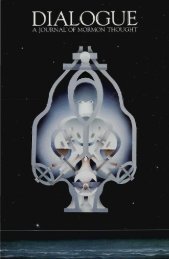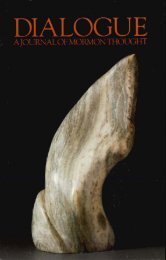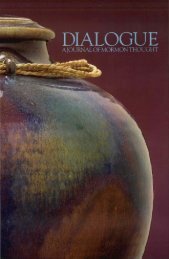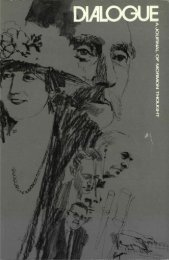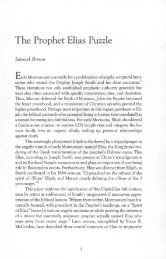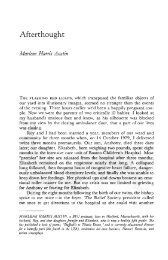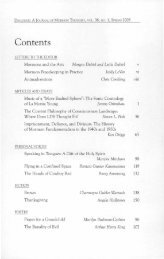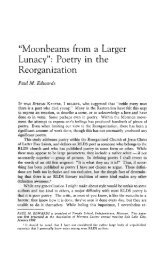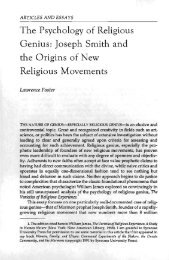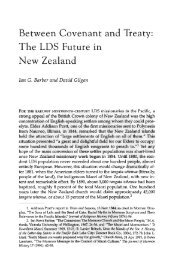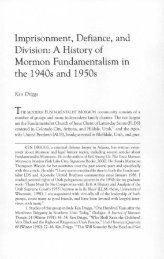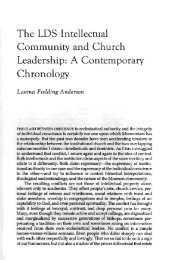Dialogue, Volume 25, Number 2 - Dialogue – A Journal of Mormon ...
Dialogue, Volume 25, Number 2 - Dialogue – A Journal of Mormon ...
Dialogue, Volume 25, Number 2 - Dialogue – A Journal of Mormon ...
Create successful ePaper yourself
Turn your PDF publications into a flip-book with our unique Google optimized e-Paper software.
Nichols: Women's Stories, Women's Lives 77<br />
My mother is into all sorts <strong>of</strong> crafts, like grapevine wreaths and quilts and the<br />
artwork for her silkscreening business. I know how to use a glue gun — I used one<br />
once to hem some pants.<br />
Kathy concludes the essay by saying that despite the gaps between<br />
her mother's achievements and her own, her mother's love and encouragement<br />
are qualities she fully intends to pass on. The essay is fun to<br />
read and allowed Kathy to safely express her marginal position within<br />
a pervasive "great story."<br />
Both these essays focus on a key role in a woman's life: the mother<br />
role. Being a mother is a pinnacle <strong>of</strong> accomplishment for a Latter-day<br />
Saint woman. Unconsciously or consciously, many LDS women examine<br />
their own propensities for this role with varying degrees <strong>of</strong><br />
satisfaction or trepidation, seeking first (like Lorinne and Kathy) to<br />
connect with their own mothers and then to come to terms with the<br />
differences between their own mothers, their own individual leanings,<br />
and the "great story" about motherhood. Writing personal narrative<br />
encourages and facilitates this process.<br />
It is especially liberating for my women students to realize that<br />
personal narrative needn't always agree with the "great story." According<br />
to Meyerh<strong>of</strong>f, the "little story" can also radically question the "great<br />
story." Often its power lies in its ability to interrogate and correct the<br />
inadequacies in the larger cultural narrative. When Nellie Brown was<br />
my student, she tried to write pieces about her frustration with what<br />
she saw as the voiceless, nameless position <strong>of</strong> women in the Church.<br />
Not until she wrote "There's No Place Like Home" (DIALOGUE, Spring<br />
1992) was she able to connect her childhood experiences, which don't<br />
fit the LDS "great story" about women as good, nurturing mothers,<br />
and her current discomfort. In all <strong>of</strong> her efforts, Nellie sought to name<br />
the origins <strong>of</strong> her wounds and to find balm for them. It was this essay,<br />
written after our class was over, describing in fearful detail moments<br />
<strong>of</strong> abuse and denial, which finally had the power to initiate real healing.<br />
It is a moving and powerful piece in which Nellie interrogates two<br />
"great stories." The first is that mothers are perfect (Kathy's essay also<br />
corroborates this). The second is what Nellie's mother told her: little<br />
girls shouldn't speak about wrongs done to them. Fear <strong>of</strong> reprisal may<br />
have silenced Nellie until she wrote this essay, but her story powerfully<br />
imagines a better way. "Do I dare / Disturb the universe?" asks T. S.<br />
Eliot's Prufrock (1971, 4). Nellie and other writers like her do so dare,<br />
aiming to change the universe for the better. Toward the end <strong>of</strong> her<br />
essay, Nellie says:<br />
I am ashamed <strong>of</strong> [these memories <strong>of</strong> cruelty.] [They] force me to admit that<br />
my mother was a child abuser. ... I feel that I should say I love my mother, that



